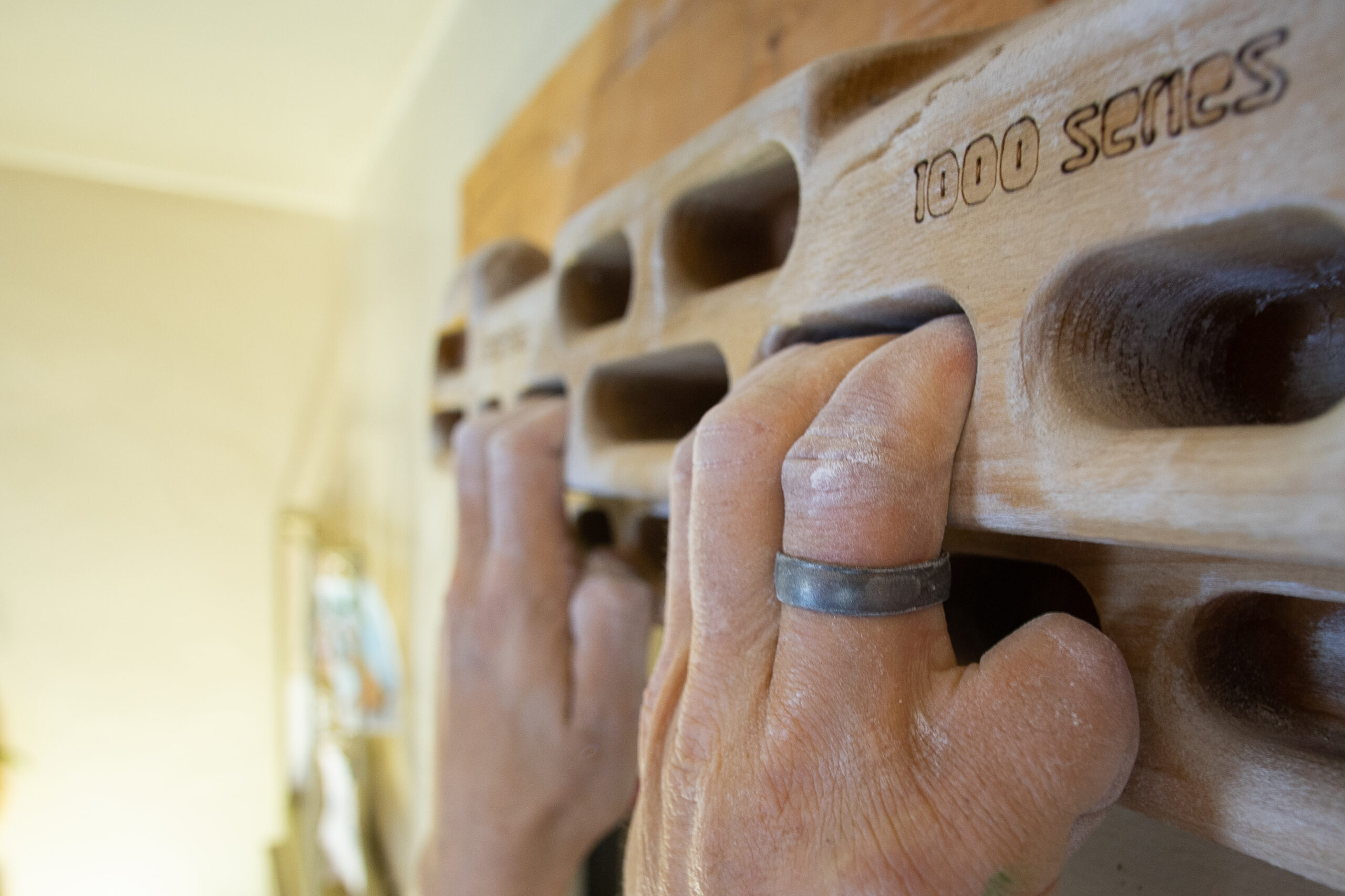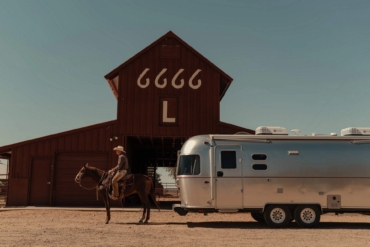A custom GearJunkie van has been years in dreaming. Then, in 2020, we put our plans down in one place and contacted VanDoIt to bring our adventure dream vehicle to life.
Pull into a popular trailhead or a ski-resort parking lot on any given weekend and you’re bound to see the silhouette of a tall-roof van. Mercedes Sprinter, Ram ProMaster, Nissan NV, Ford Transit: These oversize models now dominate the adventure market, from weekend warriors to van-lifers who exist fully on the road.
GearJunkie joined the club a couple of years back. Multiple editors, contributors, and gear-testers on our team own vans for their equipment-hauling capabilities and comfort as a place to hang out, cook, and sleep.
We have VW Vanagons, a Mitsubishi Delica, a Chevy Express, and even a few minivan conversions where a dirtbag writer can slip into a parking spot and camp on the sly.

The options go on. People tinker and build their own vans out, or they hire a specialist to engineer the interior to exact specs. The end result is an escape pod, a movable adventure home, and a gear-hauler with tables and shelves, drawers, hooks, lights, a clothesline, water tank, heaters, and fans.
On top is often a solar array, wired to a power station and batteries inside, completing the circle for survival and comfort for days spent off the grid. Here’s a look at how we jumped in with both feet to the adventure van lifestyle.
Vandoit: Ford Transit Adventure Van
Vandoit exists as an alpha company within this great swirl. Based in Blue Springs, Missouri, and with decades of experience in the automotive space, the company pivoted into adventure vans with a new division launched in 2017.
Three builds by Vandoit now occupy the GearJunkie and AllGear orbit, including the van featured in this story as well as models owned by staff editor Seiji Ishii and the Editor-in-Chief of Bikerumor, Tyler Benedict.

The latest edition, the GearJunkie Adventure Van, came to life after a few months of planning in 2020. We met Vandoit at a trade show and began to organize a build that could serve as a basecamp vehicle for multiple passengers on gear-test trips.
Its rooftop tent and fold-down bunks would sleep four or more people inside. Components and accessories from a dozen brands add both features for comfort and performance on backcountry roads.
Like all Vandoit models, the result is a unique creation, custom-built for GearJunkie’s various needs, from ski trips to industry events. It can haul a family of five or more with two rows of seats.
Remove the benches when it’s just a couple on the road and the van opens up to offer more than 300 cubic feet of space, a camper with a full bed, and a slide-out gear tray on the back.

GearJunkie Custom Adventure Van
Power, Electricity, and Features
Electricity for the vehicle comes from solar panels on top and a power system inside. We went with Goal Zero and its Boulder 100 solar panels.
A pair of the tempered glass- and aluminum-framed Goal Zero panels sit on the roof above the driver area, and they connect to the Vandoit power station and batteries inside.
The result is an off-grid solution that can run computers, chargers, and any number of components inside the van. There are standard 110V outlets throughout the vehicle and USB ports and auxiliary power outlets up front.

A set of refrigerators can run full-time on this power grid. For our build, the Dometic CDF 11 Powered Cooler sits in front to the right of the driver seat, allowing access to drinks and snacks while we drive.
The large Dometic CFX 65W Electric Cooler is a 60L tank that can keep days’ worth of food and beverages cold in the back. It has been a mainstay feature on every trip, serving as a hub for meals and while hanging out.
The unit has settings that are controllable through a range of temperatures, functioning as a refrigerator or a freezer. In addition, its electronics are dialed for efficiency for the low power consumption needed when you are off-grid.
A standard air conditioner from the Ford factory cools the vehicle when it’s on. But for temperature regulation once at a camp, we upgraded with the MaxxFan Deluxe.
It mounts into the ceiling in a 14 x 14-inch hole and pulls in cool air (or reverses to push hot air out) to regulate the van’s temp on hot days. The 12V fan motor and 12-inch, 10-blade fan moves air fast and effectively.
Electricity Required: Powered Features Continue
Dozens of additional features make our build both versatile and unique. A 32-inch screen folds down from the ceiling. It connects to a DVD player, providing entertainment for passengers on long rides.
Up front is a communication station from Midland. The MXT275VP4 MicroMobile bundle, which looks like a CB radio, is a base station and antenna system that adds significant range for staying in contact with Midland handheld walkie-talkies away from the van and in the field.
For cell connection, we installed the WeBoost Drive X RV from Wilson Electronics. The antenna allows more bars on a phone when at the edge of a cell network, reaching distant cell towers when parked or in motion.
Overall, the van comes stocked with a healthy amount of power-sucking accouterments. Add to this phones and other electronics plugged in to charge, and you can see why Vandoit custom-builds its own “power tower” in the back.
Power Station, Batteries for Van
Indeed, open the rear doors and on the left is a plexiglass case reminiscent of a custom gaming PC — wires, lights, LED panels, switches, and battery packs humming with life.

Used off and on, everything in the van — fridge, lights, screen, chargers — will run for 24 hours or more before a recharge is needed. If used minimally, electricity will last for several days off-grid. The Goal Zero panels replenish the batteries automatically, and a dashboard in the back of the van gives real-time stats on power capacity and use.
It runs off the Goal Zero solar array, and the tower also interfaces with the van’s factory power system, letting the setup recharge as you drive. At a stop, a shore power hookup on the outside lets you plug in with an extension cord to a 110V wall outlet.
As a final level, we considered a gas generator to provide power away from the van, or in a worst-case scenario, if the batteries drained after days off-grid. Instead, we went with the Goal Zero Yeti 1500X, which is a portable power station with a massive lithium-ion battery and the capability to “run anything you could from a wall outlet,” as the company puts it.
Seven plug-in options, from USB-C to 120V AC ports, make the Yeti 1500X usable for about anything that has a cord. We employ the dual 120V AC ports the most, including for recharging computers and video equipment on picnic tables adjacent to the van.

Upgrades and Luxuries Included
Beyond the in-situ or infrastructural items like power, ceiling fans, and solar panels, products from camp chairs to storage boxes add to usability and comfort. In our build, accessories from Big Agnes, YETI Coolers, Thule, and more, were key.
The LoadOut GoBox 30 from YETI stores our kitchen gear and small, essential camp items in the van. The set of these flip-open cases stack out of the way. This offers a convenient, rugged organizational option that is waterproof and dustproof when left outside at a campsite.
We keep hand soap, towels, some spices for cooking, cleaning supplies, lightweight pots and pans, and several mess kit sets from UCO in the boxes. The plate/bowl setup plus a spork offers all you need to eat any kind of meal.
A LifeSaver Jerrycan is kept in the vehicle. It’s an 18.5L vessel with a built-in filter capable of purifying up to 10,000 L of water.
Cold storage beyond the electric fridges in the van comes from YETI as well. The Tundra 65 Hard Cooler is a basic but bomber ice chest with the company’s tight-sealing latches, rubber feet, and a drain. The 16 x 30 x 17-inch unit doubles as a bench outside when we stop.
Camp chairs and a table from Big Agnes pack small and are quick to deploy. The Big Six Camp Chair has a tall back and sits 20 inches off the ground. For a quick table, we unfold the company’s Soul Kitchen Camp Table Deluxe model. Its tabletop is about 24 inches off the ground. At this height, it provides a nice platform for cooking, eating, or playing cards after dark.
From front to back, there are a hundred features to break down. The video below gives a quick tour of the van.
Roof Rack, Exterior Features in Van
On the roof, a custom 12-foot rack made at Vandoit supports the solar panels and a Tepui rooftop tent. Mounted more conspicuously are a shovel, the DMOS Delta Shovel, and the antenna for a Drive X RV cell booster.
The tent takes up much of the real estate on top. Our Tepui Ruggedized Autana 3 was made for off-road living, with thick polyester-cotton walls and a welded aluminum frame.
Tepui, which is a brand owned by Thule, has made the tent easy to manage. It unfolds quickly and pops up into place. A ladder off the rear of the tent provides access and support. Climb inside and you have a plush platform with a built-in foam mattress that sleeps three adults comfortably up high.
The tent is large and adds wind drag as you drive. It measures about 122 x 56 x 52 inches, and it weighs about 190 pounds. Once installed, taking the Tepui tent on and off requires some work. But having an always-ready spot to sleep as you travel is pretty sweet.

Another Thule addition, I love the awning on this van. It is one of the nicest features of the vehicle. The HideAway awning travels concealed and tightly rolled in its case. But at a stop, you insert a crank arm to unroll a 10 x 8 foot covering. This immediately converts the van from a vehicle to an oasis on sunny days.
We often roll the HideAway out and swing open the side door. Add a rug and camp chairs, and in two or three minutes, the van converts to a comfortable base where you can hang out, eat, and plan the day.
Open the back doors on the van and the floor pulls out on a track. This gear tray is a wonderful feature for organizing gear or stowing bikes for transport. It supports about 700 pounds and slides like a drawer several feet off the rear.
You can stack bins with gear or secure mountain bikes on mounts. The tray offers a nice seating spot, too. And with the rooftop tent unfolded above, it’s another ensconced spot protected from rain or sun.
Light Bar Bumper, All Terrain Tires
A black bar bumper and two big lights from Lightforce on the front of the van up the badass quotient of the van and provide off-road visibility.
The bumper, called the Aluminess Light Bar model, protects the vehicle with its aluminum pipes. The Lightforce HTX units are supported on this setup, giving an extra set of headlights that literally turn night into day.

A caveat: These headlights are not legal for public roads. Their 13,500-lumen output far exceeds state brightness laws. But off-road, the Lightforce lights carve a bright tunnel ahead for you to safely drive.
The Australian-made HTX lights are hybrid blazers with HID and LED technology. There is an “instant flood” with the LED glow, and then long-distance beams shoot from the HID bulbs.
The HTX lights are a safety feature as much as a nice-to-have. In multiple instances, we have deployed these beams for navigating tricky terrain at night. They gave detail to the dirt track ahead, allowing us to see every little obstacle like it was high noon.
A final notable upgrade, we went with BFGoodrich KO2 All-Terrain tires. These tires function on everything from freeways to backroads, a great hybrid that offers traction and efficiency. A side benefit is the aggressive aesthetic. The KO2 tires have a toothy side profile that adds significantly to the adventure theme of the van.
GearJunkie has long relied on the KO2 All-Terrain tires. They function in nearly all conditions, including snow. Recently, the company extended its guarantee on the tires. The tires are now backed with a 50,000-mile warranty for long life on the road.

Custom Adventure Van: Budget, Costs
We didn’t have $200,000 for the project. Look at the adventure-van market and you’ll see price tags more often associated with a mortgaged house.
Vandoit has a system that sets costs in a more manageable sphere, leaning on a leasing program within parent company Kline Motors.
Ford Transit vans start their life at Kline as shuttles or vehicles in a corporate fleet. At around 20,000 miles, the Transits are pulled into the Vandoit factory space and overhauled for the adventure set.

The result is an immediate discount on the cost. A new Transit can cost $40,000 to $50,000, depending on configuration. Vandoit’s program saves a buyer $10,000 or more off the sticker price.
Granted, that money is reallocated into the conversion to adventure-mobile. But a fully built van from the company can run as low as $48,800.
GearJunkie’s van was priced at about $69,000. This included the base vehicle — a 2018 Ford Transit Mid-Roof T-350 with less than 19,000 miles — and then the full custom build, inside and out. (Note: That price does not include products like the coolers, furniture, and other accessories highlighted in this article.)
Why Ford Transit for a Campervan?
In addition to the economics, the Ford Transit is a good choice as a base vehicle on a few fronts. First, the van is built on the F150 platform, which is among the top-selling vehicles of all time.
It is known to be extremely reliable, and parts (and mechanic knowledge) are nearly ubiquitous. In addition, there are 3,000 Ford dealers out there, so on the road, you will almost always be near one if any need arises.
Vandoit deals almost exclusively in Ford Transits.
“We have a huge level of trust in the Transit because we have leased hundreds of them and they have performed so well. People love them. They drive like a high-quality car,” the company notes.

I can concur. Though the van is not small, its steering is tight and the acceleration is surprisingly peppy for such a big beast. Visibility is not an issue, given the van’s large side mirrors and backup camera. Several people have commented on how easy it is to drive, even if at first the large campervan looks intimidating.
One letdown might be its fuel consumption. Depending on the load being hauled, or the number of passengers, we are often getting around 15 mpg on the highway, and as low as 10 mpg when hauling a trailer full of bikes and gear.
The rooftop tent and other accoutrements on the roof most likely do not help. And at a certain speed (usually above about 75 mph), the road noise from those products up high becomes noticeable inside.
Vandoit: ‘World’s Most Modular Campervan’
Vandoit is among the largest adventure-van and campervan converters in the world. When I visited the facility to pick up our vehicle a few months ago, the factory floor buzzed with activity. A dozen vans in various stages of completion were in sight.
The company touts its lasers, water jets, robots, 3D printers, and more than $2 million invested in research and development. It has produced more than 500 vans in the past 4 years, and the demand is growing.
Jared McCauslin was my concierge during the build process, working with parts brands and designers in-house at the company to integrate an explosion of details into one place.

Vandoit touts one of its value propositions as “an affordable custom van created by adventurers.” McCauslin is certainly one such, having conceived the Vandoit brand 6 years ago. He said he saw a space in the market for open-floorplan, customizable vans.
That collided with the #VanLife trend beginning in about 2017 and the pandemic-fueled craze of open road trips and domestic travel.
The result is a 40-person business now that is pumping out up to six custom vans per week. Unfortunately, Vandoit, like many custom van-builders, is backed up and has a waitlist.
But the company has many offerings for aspiring van-lifers, including pre-owned adventure vans and multiple models of varying cost and complexity.
Converting the Ford Transit to Adventure Van
A base feature of Vandoit vehicles is the Skeleton Grid. This interior aluminum grid on the ceiling, walls, and floor has a track system where accessories snap in and out. The result is a blank canvas where you can mount accessories and move things around.
The grid is proprietary to Vandoit, and it gives the vehicles a unique interior look. Functionally, the grid solves the “how do I mount it?” issue that DIYers can face when converting a factory interior to a made-for-camping-mobile.

Shelves, straps, tables, bed mounts, hooks, eyelets, and custom Vandoit products mount or snap into the modular grid. It is strong enough to support hundreds of pounds, including bunks where multiple people can sleep inside.
Ratchet straps unspool from the ceiling to hook the bed, creating a solid platform that’s easy to adjust, level, move up and down, and fold against a van wall when not in use.
Vandoit Van: Final Thoughts
So far, we have rolled almost 10,000 miles in the adventure van. We have traveled to bike, ski, camp, climb, and paddle. Its modular nature accommodates any mix of gear and adventure occupants traveling in the vehicle. This has included up to seven people and a dog on at least one trip.
As a camper, the van serves as a solid home base in the backcountry or at a drive-in park campground. However, with a family and all the required gear, we often leave the bunks behind and set up the Tepui on top.
We also will pitch a tent alongside the van. This way, we can use the internal vehicle space for gear and hanging out, not as a spot to sleep. Though the van is spacious, this is not a traditional RV.

Vandoit does offer a more true campervan setup. Options include an integrated sink, stove, and kitchen unit. You can even fit a small toilet inside. For a single person or a couple that can manage space and gear, the Ford Transit’s interior area is large enough to accommodate full-time living on the road.
A final personal aside: This van was probably a bit of destiny for me. My family has always been a van family. Big, boxy work vans in the 1980s when I was a kid, raw inside, with bins and tools rattling as we drove.
Then, when I was a teenager, we bought a conversion van equipped with plush “captain’s seats” in the middle row. We spent untold weekends on the road as a family, packed in with skis or camping equipment.
My honeymoon was in a van, with my wife and I taking a 2-week road trip through Canada and down the East Coast. Now, as a family man with kids, we have owned multiple minivans and a used VW that was neat but also a bit of a lemon, as it wore through multiple transmissions in a couple of years.
The Vandoit is the apex of this evolution, a peak van moment for me. Whether I am with friends, my family on a camping trip, or on a gear-test day with the GearJunkie crew, the Vandoit’s modular nature, drivability, spacious interior, smart features, and clean look exceed all expectations I initially had when conjuring up and designing my dream van.










